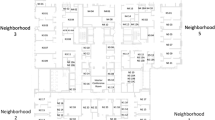Abstract
Objective:
This report describes a multidisciplinary design project conducted in an academic setting reflecting a systems-oriented, human-centered philosophy in the design of neonatal incubator technologies.
Study Design:
Graduate students in Architectural Design and Human Factors Engineering courses collaborated in a design effort that focused on supporting the needs of three user groups of incubator technologies: infant patients, family members and medical personnel. Design teams followed established human-centered design methods that included interacting with representatives from the user groups, analyzing sets of critical tasks and conducting usability studies with existing technologies.
Result:
An iterative design and evaluation process produced four conceptual designs of incubators and supporting equipment that better address specific needs of the user groups.
Conclusion:
This report introduces the human-centered design approach, highlights some of the analysis findings and design solutions, and offers a set of design recommendations for future incubation technologies.
This is a preview of subscription content, access via your institution
Access options
Subscribe to this journal
Receive 12 print issues and online access
$259.00 per year
only $21.58 per issue
Buy this article
- Purchase on Springer Link
- Instant access to full article PDF
Prices may be subject to local taxes which are calculated during checkout





Similar content being viewed by others
References
Antonucci R, Porcella A, Fanos V . The infant incubator in the neonatal intensive care unit: unresolved issues and future developments. J Perinat Med 2009; 37: 587–598.
Baker JP . The incubator controversy: Pediatricians and the origins of premature infant technology in the United States, 1890–1910. Pediatrics 1991; 87: 654–662.
Baker JP . The incubator and the medical discovery of the premature infant. J Perinatol 2000; 5: 321–328.
Cermakova E . Study of extremely low frequency electromagnetic fields in infant incubators. Int J Occup Med Envi 2003; 16: 215–220.
Brown G . NICU noise and the preterm infant. Neonatal Netw 2009; 28: 165–173.
Davis A, Wood S . The epidemiology of childhood hearing impairment: factors relevant to planning of services. Br J Audiol 1992; 26: 77–90.
Rivkees S, Mayes L, Jacobs H, Gross I . Rest-activity patterns of premature infants are regulated by cycled lighting. Pediatrics 2004; 113: 833–839.
Graven SN, Browne JV . Sleep and brain development: The critical role of sleep in fetal and early neonatal brain development. Newborn Infant Nurs Rev 2008; 8: 173–179.
Benz P, Rygielski Preston L . Improving quality of care while going green. Environmental Design+Construction (EDC) [Internet] 2011 March 30 (cited 3 July 2012). Available from http://www.edcmag.com/articles/improving-quality-of-care-while-going-green.
Marshall-Baker A . Human and environmental health: Sustainable design for the NICU. J Perinatol 2006; 27: S31–S33.
Drexler M . Looking under the hood and seeing an incubator. The New York Times 2008 December 15 (cited 3 July 2012). Available from http://www.nytimes.com/2008/12/16/health/16incubators.html.
Carayon P, Schoofs Hundt A, Karsh B-T, Gurses AP, Alvarado CJ, Smith M et al. Work system design for patient safety: the SEIPS model. Qual Saf Health Care 2006; 15 (Suppl I): i50–i58.
Norman DA, Draper SW . User Centered System Design; New Perspectives on Human-Computer Interaction. Lawrence Erlbaum Associates: Hillsdale, NJ, 1986.
Wickens CD, Lee JD, Liu Y, Gordon-Becker SE . An Introduction to Human Factors Engineering 2nd edn Prentice Hall: New Jersey, 2004.
Dokken D, Ahmann E . The many roles of family members in ‘family-centered care’–part I. Pediatr Nurs 2006; 32: 562–565.
Kirwan B, Ainsworth LK . A guide to task analysis. CRC Press: London, 1992.
Shepley MM, Harris DD, White R . Open-bay and single-family room neonatal intensive care units: caregiver satisfaction and stress. Environ Behav 2008; 40: 249–268.
Smith TJ, Schoenbeck K, Clayton S . Staff perceptions of work quality of a neonatal intensive care unit before and after transition from an open bay to a private room design. Work 2009; 33: 211–227.
Nielsen J . Heuristic evaluation In Nielsen J, Mack RL, (eds). Usability Inspection Methods. John Wiley & Sons: New York, NY, 1994.
Nielsen J . Heuristic evaluation. Jakob Nielsen, 2005 (cited 3 July 2012). Available from http://www.useit.com/papers/heuristic/.
Zhang J, Johnson TR, Patel VL, Paige DL, Kubose T . Using usability heuristics to evaluate patient safety of medical devices. J Biomed Inform 2003; 36: 23–30.
van de Glind I, de Roode S, Goossensen A 2007 Do patients in hospitals benefit from single rooms? Health Policy 2007; 84: 153–161.
Acknowledgements
We thank the students of the two classes for their outstanding efforts in this project. We also thank to Dr Robert White, Dr Debra Harris, Tamara Congdon and the NICU nursing staff at St Joseph’s Regional Health Center in Bryan, TX, for providing user group input, and GE Healthcare for providing the Giraffe Incubator equipment, which was used by the design teams in usability evaluation studies and also for general design reference. Finally, we thank the TAMU Industrial and Systems Engineering and Architecture departments for in-kind support. This publication has been sponsored by Lifespan Healthcare LLC, Philips Healthcare and Pediatrix Medical Group. The sponsoring entities for this publication had no involvement in the preparation or alteration of the manuscripts.
Author information
Authors and Affiliations
Corresponding author
Ethics declarations
Competing interests
The authors declare no conflict of interest.
Additional information
Parts of this article are adapted from material originally published in ‘A Multidisciplinary Human-Centered Approach to the Design of Incubation Systems’, in Proceedings of the 2012 Symposium on Human Factors and Ergonomics in Health Care: Bridging the Gap. Copyright 2012 by Human Factors and Ergonomics Society. All rights reserved.
Rights and permissions
About this article
Cite this article
Ferris, T., Shepley, M. The design of neonatal incubators: a systems-oriented, human-centered approach. J Perinatol 33 (Suppl 1), S24–S31 (2013). https://doi.org/10.1038/jp.2013.11
Published:
Issue Date:
DOI: https://doi.org/10.1038/jp.2013.11
Keywords
This article is cited by
-
Making the invisible visible: New perspectives on the intersection of human–environment interactions of clinical teams in intensive care
Journal of Perinatology (2022)
-
Encouraging developments in incubator design
Journal of Perinatology (2013)
-
Human-centered incubator: beyond a design concept
Journal of Perinatology (2013)


